You’ll discover that living in a small apartment doesn’t mean sacrificing the beauty of indoor plants. While space comes at a premium in urban dwellings, numerous plant species thrive in compact areas under 2-3 square feet. From the self-contained elegance of African Violets to the vertical appeal of Snake Plants reaching 24-48 inches tall, these space-efficient options can transform your limited square footage into a vibrant indoor garden.
Contents
- 1 1. Snake Plant Grows Upright
- 2 2. ZZ Plant Thrives Indoors
- 3 3. Compact Pothos Trails Beautifully
- 4 4. Peace Lily Blooms Elegantly
- 5 5. Spider Plant Sprouts Babies
- 6 6. Chinese Evergreen Loves Shade
- 7 7. Aloe Heals While Growing
- 8 8. Philodendron Adapts to Corners
- 9 9. Lucky Bamboo Grows Vertically
- 10 10. Christmas Cactus Blooms Seasonally
- 11 11. Jade Plant Stores Water
- 12 12. African Violet Blooms Year-Round
- 13 13. Air Plant Needs No Soil
- 14 14. English Ivy Climbs Walls
- 15 15. Rubber Plant Grows Glossy
1. Snake Plant Grows Upright

The snake plant’s upright growth habit makes it an excellent choice for tight spaces in apartments. Its stiff, sword-like leaves grow vertically, reaching heights of 2-4 feet while maintaining a narrow footprint. These architectural leaves grow in dense clusters from the base, creating a striking vertical accent that takes up minimal floor space while adding visual interest to any room.
- Light: Tolerates low light but thrives in bright, indirect light; can handle some direct sun
- Water: Allow soil to dry between waterings; water sparingly in winter; highly drought-tolerant
- Soil: Well-draining potting mix; prefers slightly sandy soil
- Temperature: 60-85°F (15-29°C)
- Humidity: Adaptable to most indoor humidity levels
- Container: Use pot with drainage holes; doesn’t require frequent repotting
- Fertilizer: Light feeding with balanced fertilizer during growing season
2. ZZ Plant Thrives Indoors
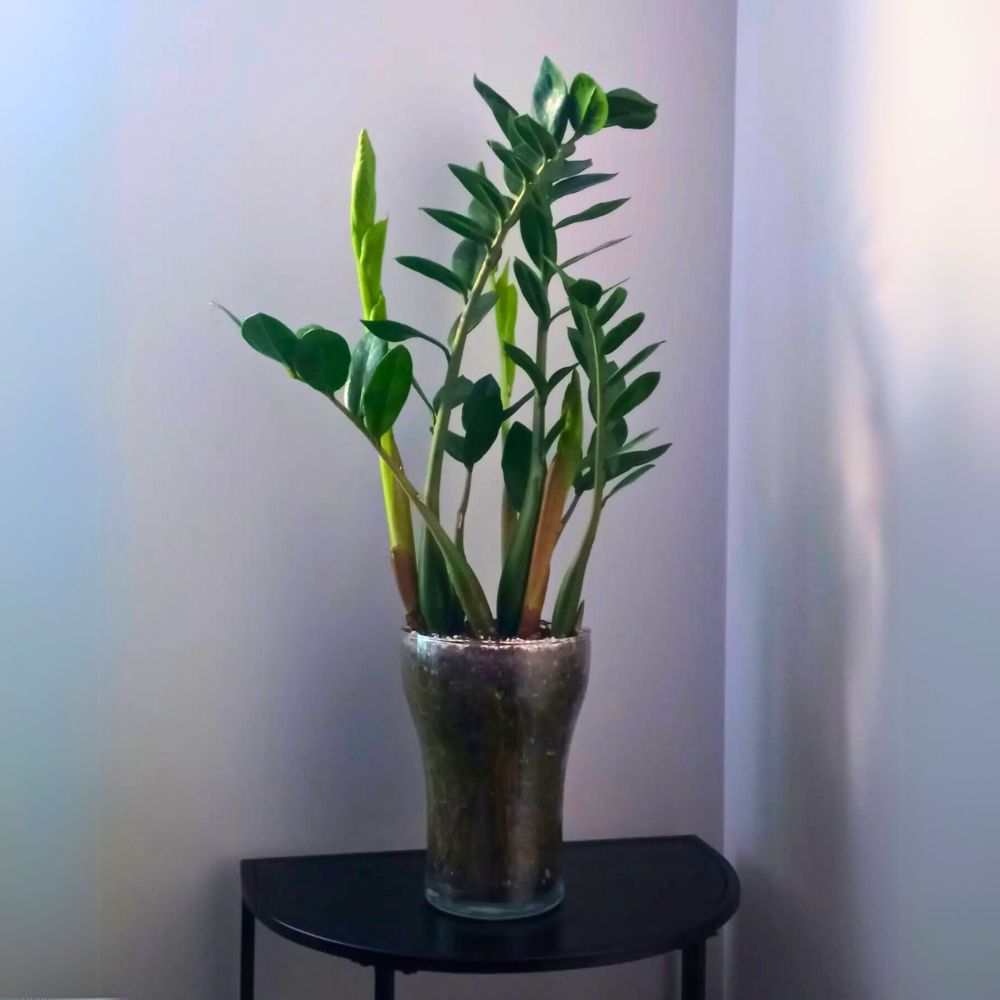
The ZZ Plant (Zamioculcas zamiifolia) is a remarkably resilient houseplant that flourishes in indoor environments with minimal care. Its thick, glossy leaves grow on sturdy stems, creating an attractive, upright appearance that can reach heights of 2-3 feet. The plant’s exceptional tolerance for low-light conditions and irregular watering makes it particularly well-suited for apartment living, while its air-purifying qualities and slow growth rate add to its appeal as an indoor specimen.
- Light: Tolerates low to bright indirect light; avoid direct sunlight
- Water: Allow soil to dry between waterings; water every 2-3 weeks
- Soil: Well-draining potting mix
- Humidity: Adapts to normal indoor humidity levels
- Temperature: 65-75°F (18-24°C)
- Fertilizer: Light feeding every 3-4 months during growing season
- Container: Pot with drainage holes
- Soil pH: 6.0-7.0
3. Compact Pothos Trails Beautifully
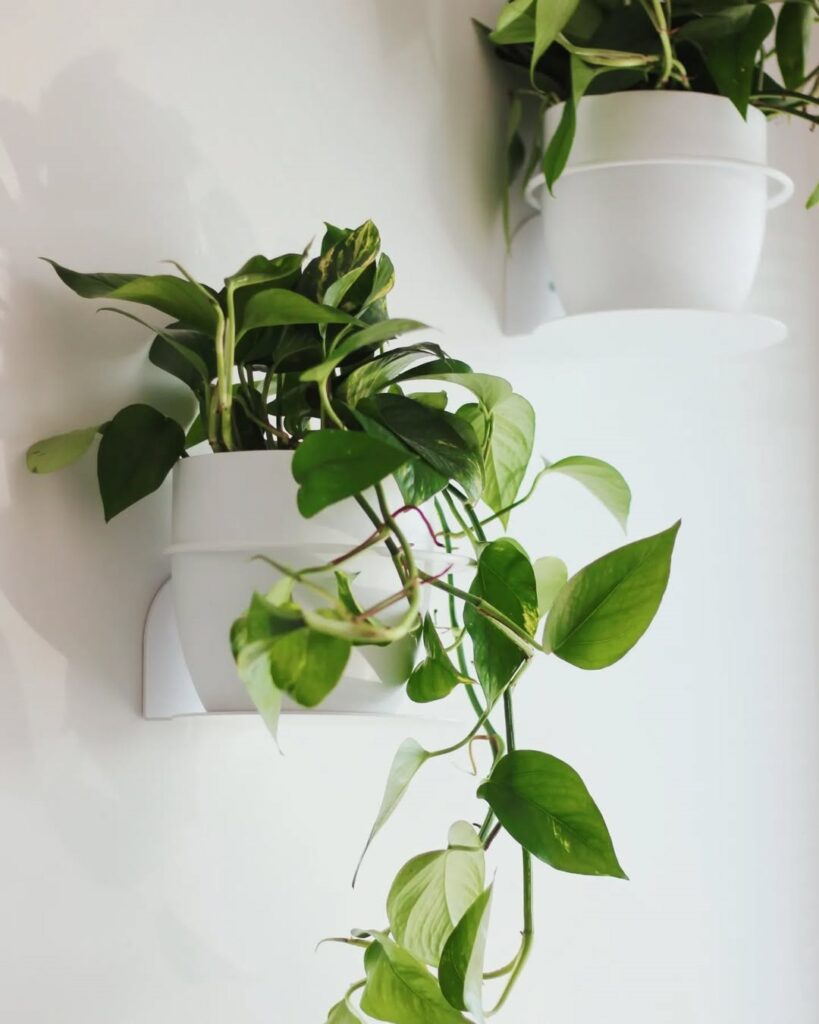
Pothos is a perfect trailing plant for apartment dwellers, featuring heart-shaped leaves that cascade elegantly from shelves, hanging baskets, or tall plant stands. Despite its dramatic appearance, this compact vine takes up minimal floor space while creating visual impact through its flowing stems that can reach several feet in length. The plant’s adaptable nature and modest size make it ideal for small spaces, and its various varieties offer options from deep green to variegated patterns.
- Light: Tolerates low to bright indirect light; avoid direct sunlight
- Water: Allow top 1-2 inches of soil to dry between waterings
- Soil: Well-draining potting mix
- Humidity: Adapts to normal household humidity levels
- Temperature: Thrives in 60-80°F (15-27°C)
- Container: Any pot with drainage holes; can start in 4-6 inch pots
- Fertilizer: Light feeding with balanced fertilizer every 2-3 months during growing season
- Pruning: Trim long vines to maintain desired length and encourage fullness
4. Peace Lily Blooms Elegantly
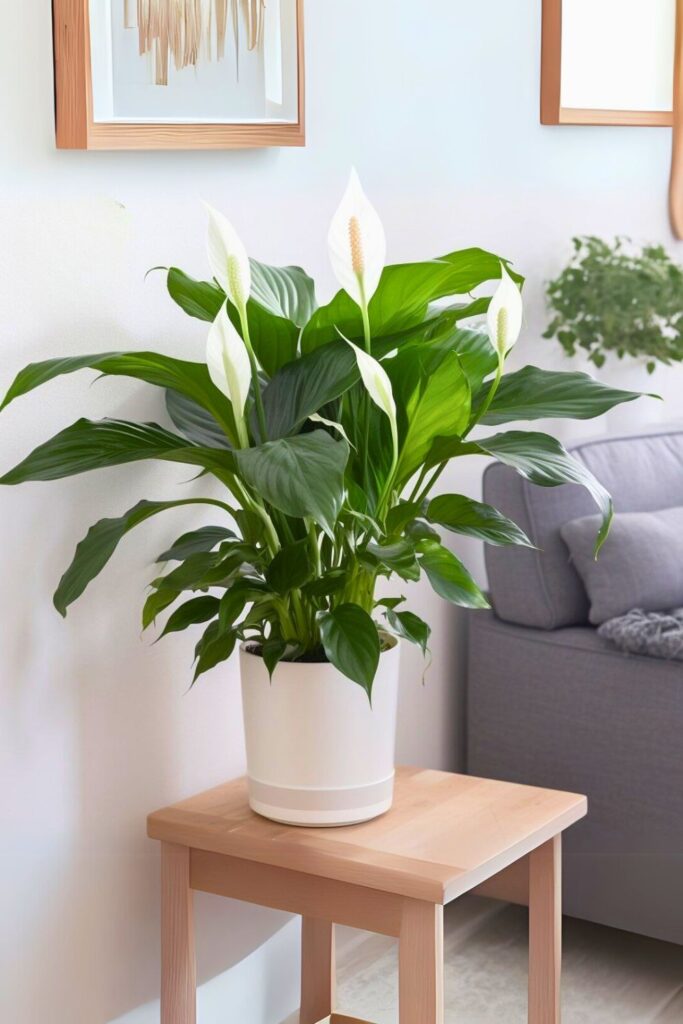
The Peace Lily (Spathiphyllum) is a graceful indoor plant known for its distinctive white flower-like spathes and glossy dark green foliage. This compact beauty typically reaches heights between 1-4 feet, making it perfect for apartment spaces. The plant produces its iconic blooms throughout the year, with each flower consisting of a white hooded bract surrounding a spike-like spadix, creating an elegant, sophisticated appearance that enhances any room’s ambiance.
- Light: Thrives in medium to low indirect light; avoid direct sunlight
- Water: Keep soil consistently moist but not waterlogged; water when top inch of soil feels dry
- Soil: Well-draining potting mix rich in organic matter
- Humidity: Prefers high humidity; mist leaves regularly or use a humidity tray
- Temperature: Maintains best growth between 65-80°F (18-27°C)
- Fertilizer: Feed with balanced liquid fertilizer every 6-8 weeks during growing season
- Soil pH: Slightly acidic to neutral (6.0-7.0)
5. Spider Plant Sprouts Babies
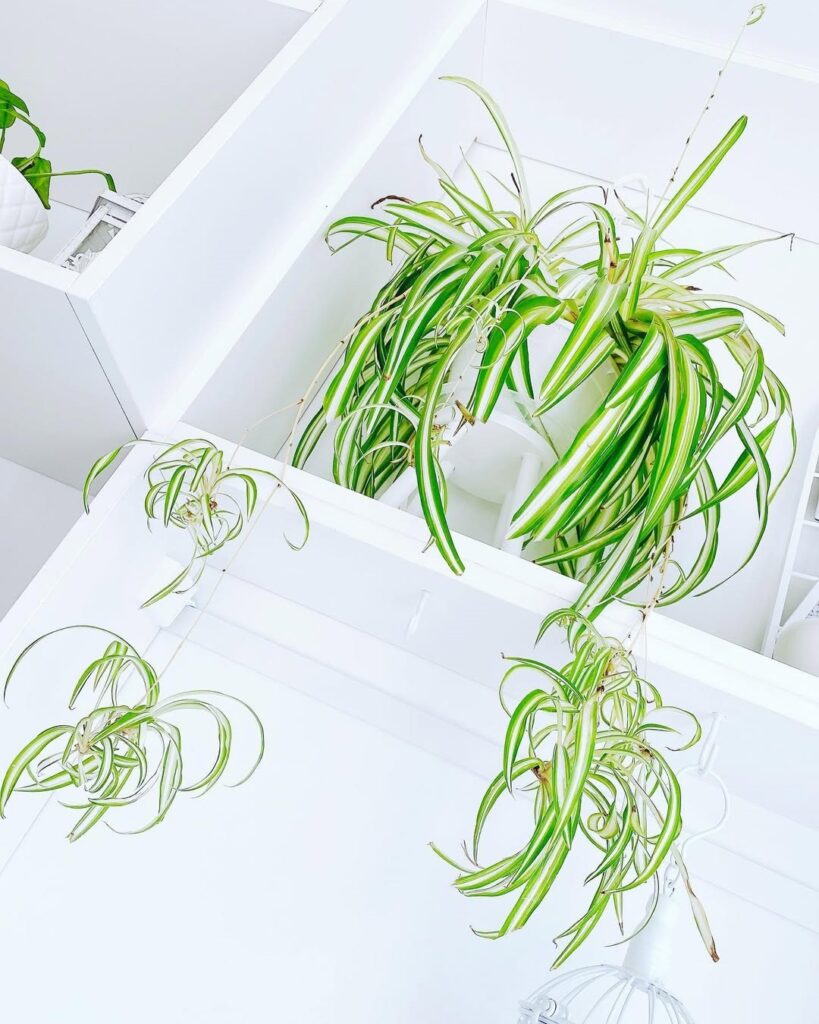
Spider plants (Chlorophytum comosum) are well-known for their ability to produce miniature offspring, called plantlets or “babies,” which dangle from long stems like tiny spiders on a web. These plantlets develop naturally when the mother plant is healthy and mature, typically appearing in spring and summer. Each baby plant can be easily propagated by placing it in soil while still attached to the parent, then cutting the stem once roots have developed.
- Light: Bright indirect light; can tolerate lower light but may not produce as many babies
- Water: Keep soil lightly moist; water when top inch of soil feels dry
- Soil: Well-draining potting mix
- Temperature: 60-75°F (15-24°C)
- Humidity: Tolerates average household humidity
- Fertilizer: Feed monthly during growing season with balanced liquid fertilizer
- Pot Type: Any container with drainage holes
- Soil pH: 6.0-7.2
6. Chinese Evergreen Loves Shade

Chinese Evergreen (Aglaonema) is a perfect choice for dim apartment corners where other plants struggle to survive. This tropical beauty features striking variegated leaves in patterns of green, silver, and sometimes pink, making it both an attractive and practical choice for indoor spaces with minimal natural light. Its compact growth habit and tolerance for less-than-ideal conditions have made it a longtime favorite among apartment dwellers and office workers.
- Light: Thrives in low to moderate indirect light; can tolerate deep shade but may lose variegation; avoid direct sunlight
- Water: Keep soil lightly moist; water when top inch of soil feels dry; reduce watering in winter
- Soil: Well-draining potting mix rich in organic matter
- Humidity: Prefers moderate to high humidity; mist leaves occasionally
- Temperature: 65-80°F (18-27°C); protect from cold drafts
- Fertilizer: Feed with balanced liquid fertilizer every 6-8 weeks during growing season
- Container: Use pot with drainage holes to prevent root rot
7. Aloe Heals While Growing
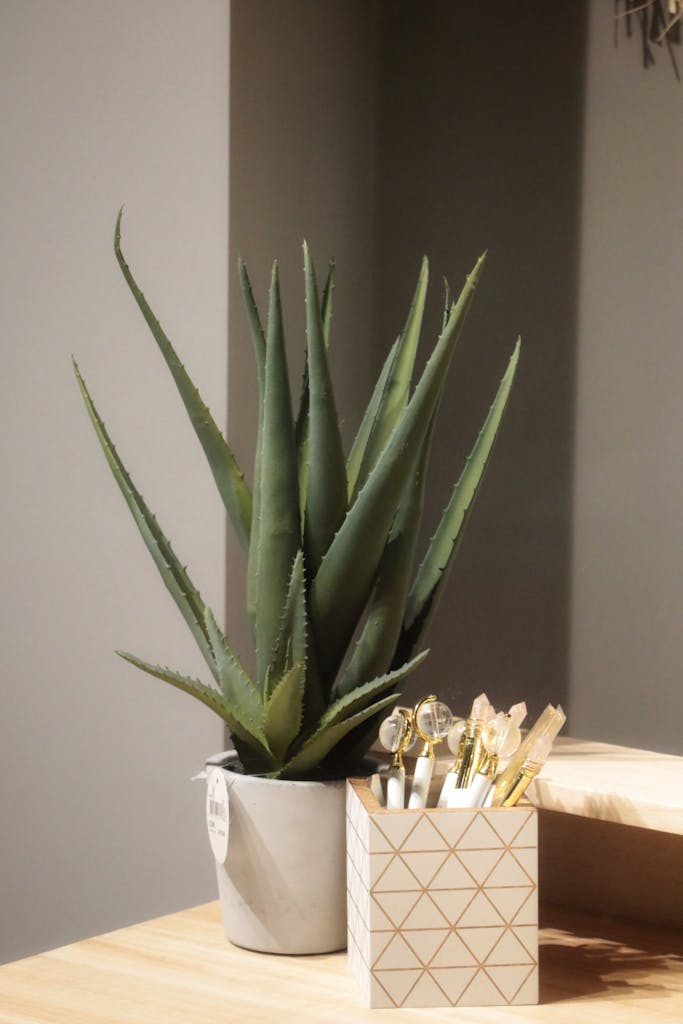
Aloe vera is a compact succulent that not only fits perfectly in small spaces but also serves as a living first-aid kit. The gel inside its thick, spiky leaves contains therapeutic compounds that can help soothe minor burns, cuts, and skin irritations. This low-maintenance plant grows slowly and can thrive for years in the same pot, making it an excellent choice for apartment dwellers who want both decorative and practical value from their houseplants.
- Light: Bright, indirect sunlight; can tolerate some direct morning sun
- Water: Allow soil to dry completely between waterings; water less in winter
- Soil: Well-draining cactus or succulent mix
- Temperature: 55-80°F (13-27°C)
- Humidity: Low to moderate; tolerates dry air well
- Container: Terra cotta pot with drainage holes
- Fertilizer: Light feeding with balanced fertilizer once in spring and summer
8. Philodendron Adapts to Corners
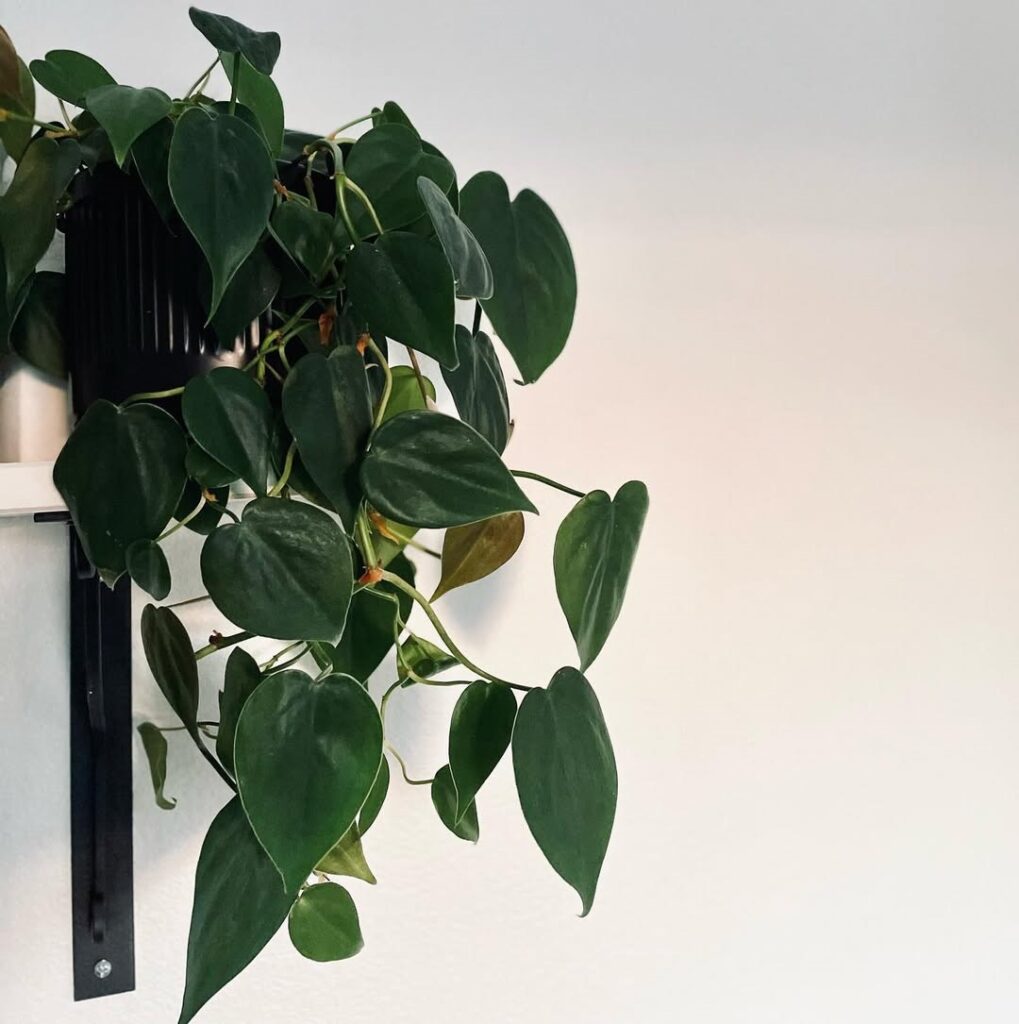
Philodendrons are excellent corner-dwelling plants that can adapt to various spatial configurations in apartments. Their climbing or trailing nature allows them to either grow upward along support structures or cascade down from elevated positions, making efficient use of corner spaces. The heart-shaped leaves can be trained to grow in the desired direction, and their natural tendency to grow toward light sources makes them particularly suitable for filling empty corner areas without taking up valuable floor space.
- Light: Bright, indirect light; can tolerate low light conditions but may grow slower
- Water: Allow top 1-2 inches of soil to dry between waterings; reduce watering in winter
- Soil: Well-draining, loose potting mix rich in organic matter
- Humidity: 40-60%; tolerates average indoor humidity
- Temperature: 65-80°F (18-27°C)
- Support: Moss pole or trellis for climbing varieties
- Fertilizer: Balanced liquid fertilizer every 4-6 weeks during growing season
9. Lucky Bamboo Grows Vertically
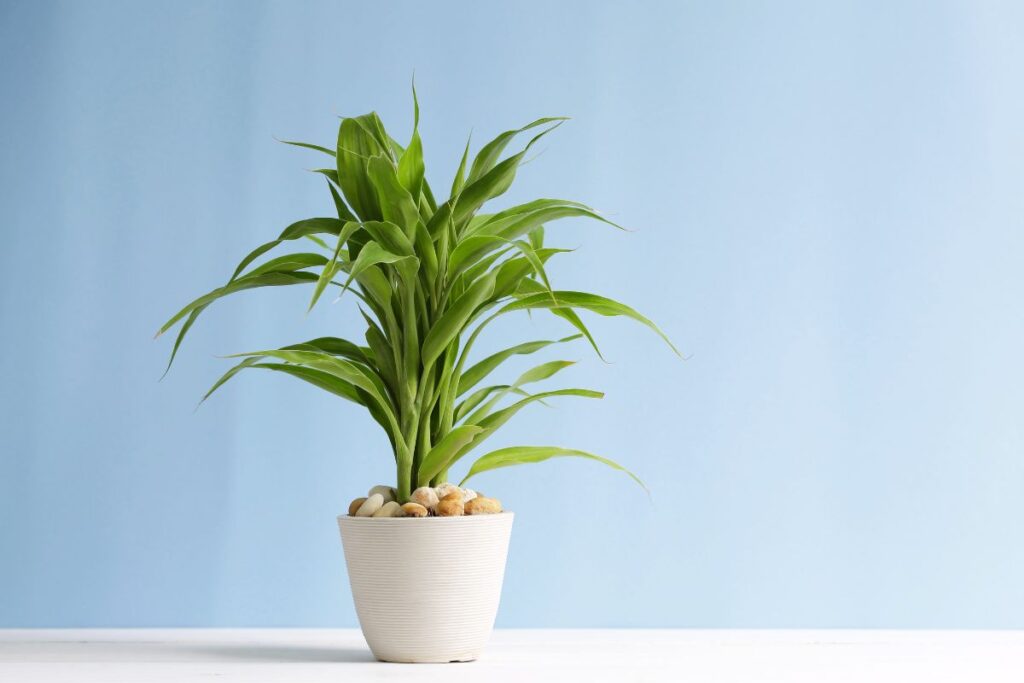
Lucky bamboo (Dracaena sanderiana) is a versatile vertical plant that thrives in small spaces, making it perfect for apartment living. Despite its name, it’s not actually bamboo but rather a member of the Dracaena family. The plant grows in stalks that can be trained into spirals or other shapes, and its height can be controlled by trimming. New shoots emerge from the main stalks, allowing the plant to grow upward while maintaining a compact footprint.
- Light: Bright, indirect light; avoid direct sunlight which can burn leaves
- Water: Clean water that covers the roots if grown in water; keep soil consistently moist if planted in soil
- Temperature: 65-95°F (18-35°C)
- Humidity: Moderate to high
- Growing medium: Can be grown in water with pebbles or well-draining potting soil
- Fertilizer: Light feeding every 2-3 months with liquid fertilizer
- Container: Small vase with pebbles for water growing; pot with drainage for soil growing
- Maintenance: Remove yellowed leaves and trim overgrown stalks as needed
10. Christmas Cactus Blooms Seasonally
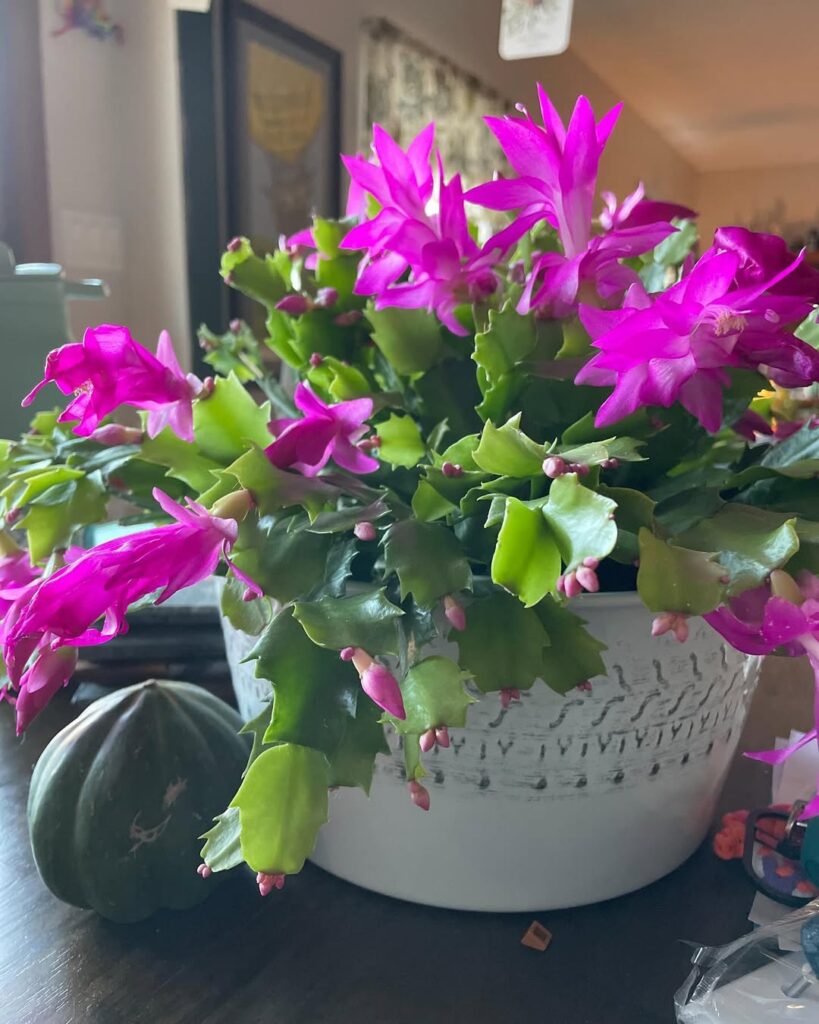
The Christmas Cactus (Schlumbergera) brings vibrant color to indoor spaces during winter months, typically blooming between November and January with pink, red, white, or purple flowers. Despite its name, this epiphytic succulent isn’t a true desert cactus but rather a tropical plant native to Brazilian rainforests. The plant produces segmented stems that cascade downward, making it ideal for hanging baskets or elevated pots, and with proper care can bloom repeatedly for many years.
- Light: Bright, indirect light; avoid direct sunlight which can burn leaves; low light during fall triggers blooming
- Water: Keep soil moderately moist during growing season; reduce watering in fall to encourage blooming
- Soil: Well-draining potting mix rich in organic matter; preferably a mix designed for cacti and succulents
- Humidity: Moderate to high humidity (50-60%)
- Temperature: 65-75°F (18-24°C); cooler nights (55-65°F) during blooming season
- Fertilizer: Monthly feeding with balanced fertilizer during growing season; stop feeding during bloom cycle
11. Jade Plant Stores Water

The jade plant (Crassula ovata) is an excellent water-storing succulent that thrives in apartment settings. Its thick, fleshy leaves act as natural reservoirs, holding moisture for extended periods and making it highly drought-tolerant. This adaptation allows the plant to survive even when watering is irregular, which is particularly beneficial for busy apartment dwellers or those new to plant care.
- Light: Bright, indirect sunlight; can tolerate some direct morning sun; needs at least 4-6 hours of light daily
- Water: Allow soil to dry completely between waterings; reduce watering in winter
- Soil: Well-draining cactus or succulent mix
- Temperature: 65-75°F (18-24°C)
- Humidity: Tolerates low humidity levels
- Container: Pot with drainage holes to prevent root rot
- Fertilizer: Light feeding with balanced fertilizer during growing season
12. African Violet Blooms Year-Round
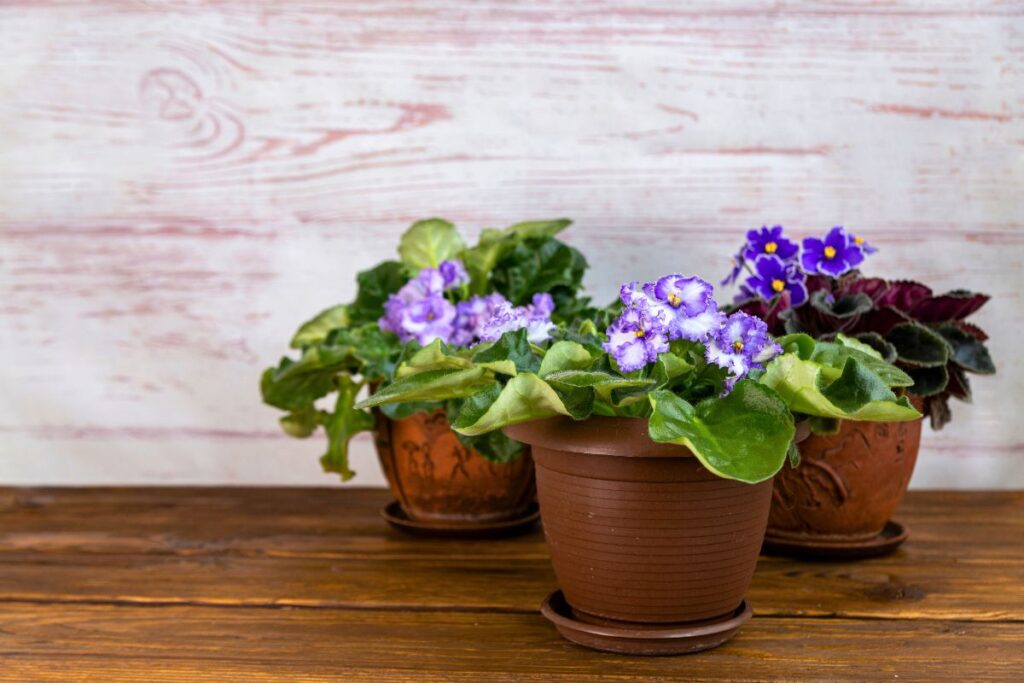
African Violets are compact flowering houseplants that can produce delicate blooms continuously throughout the year when properly cared for. These charming plants typically grow 6-8 inches tall and wide, making them perfect for small spaces like windowsills or coffee tables. Their velvety, dark green leaves form a symmetrical rosette pattern, while their flowers come in various shades of purple, pink, white, and blue.
- Light: Bright, indirect light; avoid direct sunlight; east or north-facing windows are ideal
- Water: Keep soil consistently moist but not waterlogged; water from bottom to prevent leaf damage
- Temperature: 65-75°F (18-24°C); protect from cold drafts
- Humidity: 40-60%; use humidity tray or place near other plants
- Soil: Well-draining, loose African violet potting mix
- Fertilizer: Feed every 4-6 weeks with balanced, water-soluble fertilizer
- Container: Small pot with drainage holes; prefer slightly root-bound conditions
- Spacing: Single plant per 4-6 inch pot
13. Air Plant Needs No Soil
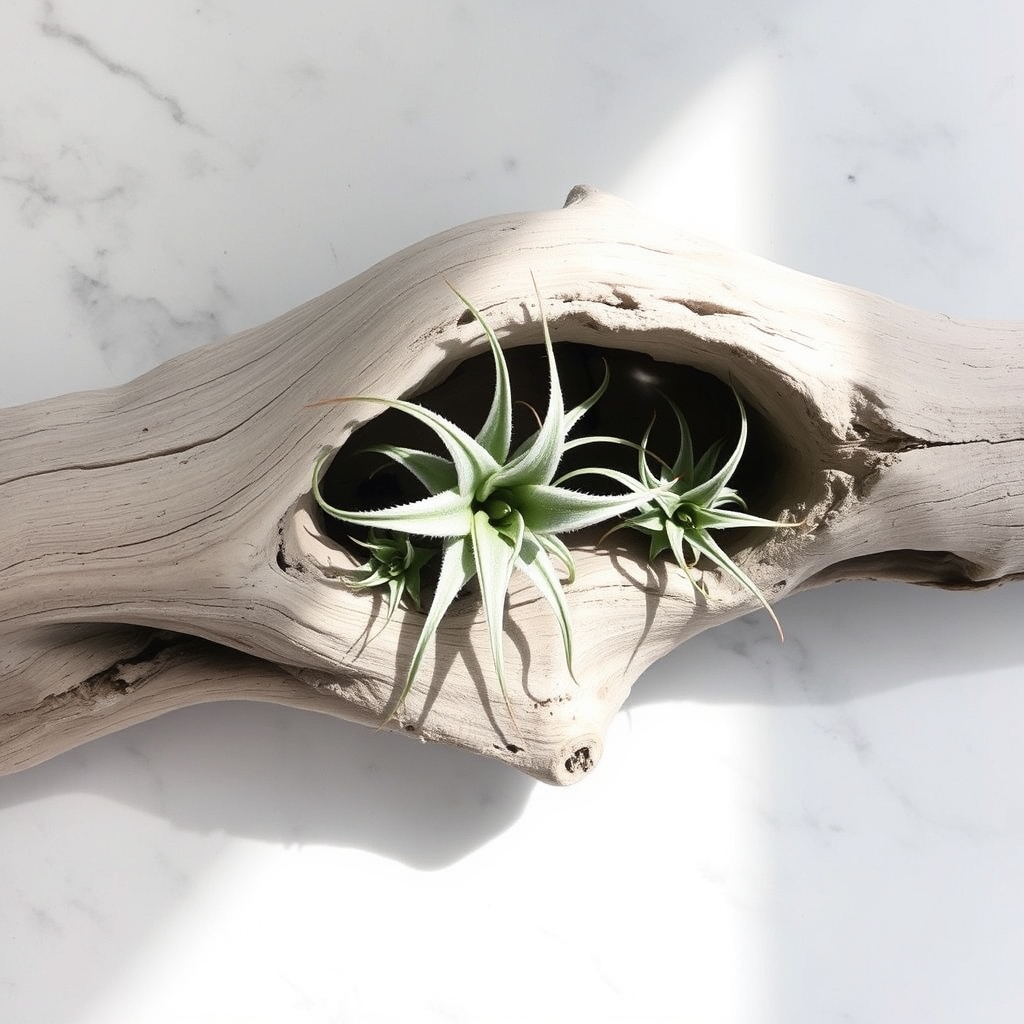
Air plants (Tillandsia) are unique epiphytic plants that grow without soil, absorbing moisture and nutrients through specialized scales on their leaves called trichomes. These fascinating plants naturally attach themselves to tree branches or rocks in their native habitats, making them perfect for small spaces as they can be displayed in creative ways such as mounted on walls, suspended in glass terrariums, or placed in decorative holders.
- Light: Bright, indirect sunlight; avoid direct sun which can burn leaves
- Water: Soak in water for 20-30 minutes every 1-2 weeks; shake off excess water
- Humidity: Prefer 60-80% humidity; mist 2-3 times weekly in dry conditions
- Temperature: Thrive in 50-90°F (10-32°C)
- Mounting: Can be glued, wired, or placed in containers without soil
- Fertilizer: Monthly feeding with air plant-specific fertilizer during growing season
- Ventilation: Good air circulation is essential to prevent rot
14. English Ivy Climbs Walls
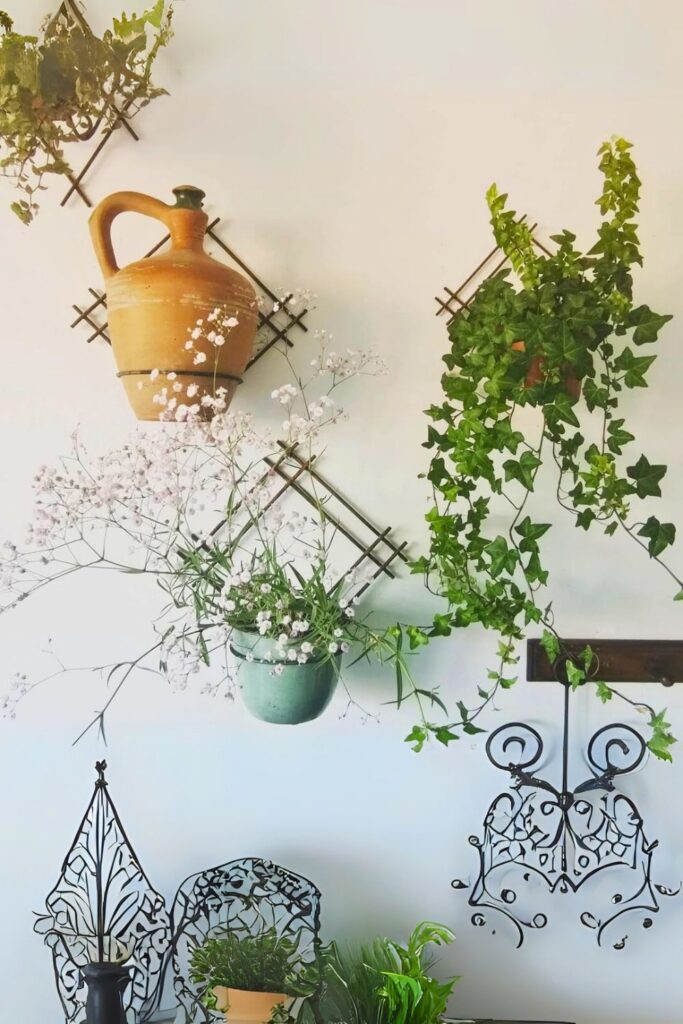
English Ivy (Hedera helix) is a versatile climbing vine that efficiently utilizes vertical space in apartments by attaching itself to walls and surfaces through aerial rootlets. This evergreen plant can transform bare walls into living green tapestries while taking up minimal floor space. As it grows, it creates an elegant cascading effect that adds visual interest and can help purify indoor air.
- Light: Bright indirect light; can tolerate low light conditions but may grow slower; avoid direct sunlight
- Water: Keep soil consistently moist but not waterlogged; water when top inch of soil feels dry
- Soil: Well-draining potting mix rich in organic matter; pH between 6.0 and 7.5
- Temperature: 50-70°F (10-21°C)
- Humidity: Moderate to high; benefits from regular misting
- Support: Needs trellis, stakes, or rough surface to climb
- Fertilizer: Feed monthly during growing season with balanced liquid fertilizer
15. Rubber Plant Grows Glossy
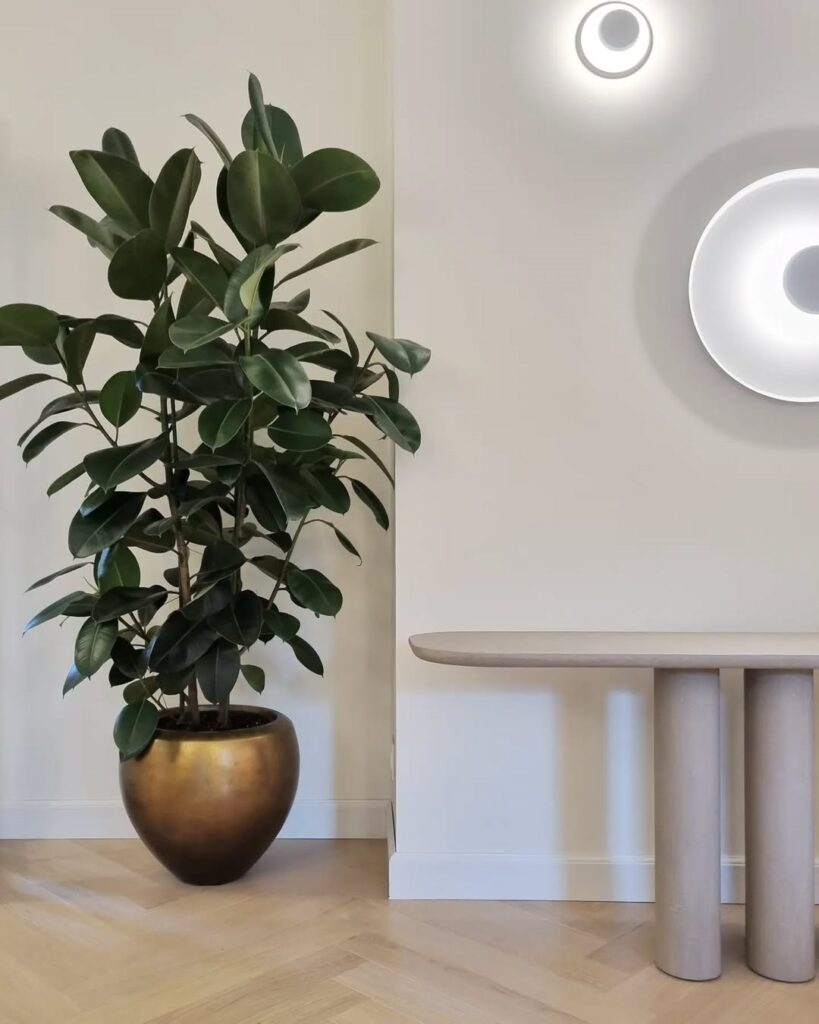
The rubber plant (Ficus elastica) is a popular houseplant known for its large, thick leaves with a glossy, polished appearance. As it matures, the leaves develop a deep, rich green color and a leather-like texture that adds sophistication to any indoor space. While it can grow quite tall in its natural habitat, the rubber plant adapts well to apartment living and can be maintained at a manageable size through regular pruning.
- Light: Bright, indirect sunlight; can tolerate some direct morning sun but avoid harsh afternoon rays
- Water: Allow top 1-2 inches of soil to dry between waterings; reduce watering in winter
- Soil: Well-draining potting mix rich in organic matter
- Humidity: Moderate to high; mist leaves regularly or use a humidity tray
- Temperature: 60-75°F (15-24°C)
- Fertilizer: Feed monthly during growing season with balanced liquid fertilizer
- Pot: Choose container with drainage holes; repot every 2-3 years as needed
